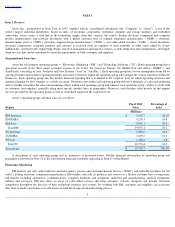Avnet 2012 Annual Report Download - page 12
Download and view the complete annual report
Please find page 12 of the 2012 Avnet annual report below. You can navigate through the pages in the report by either clicking on the pages listed below, or by using the keyword search tool below to find specific information within the annual report.
Table of Contents
Under certain of its credit facilities, the Company is required to maintain certain specified financial ratios and meet certain tests. If the
Company fails to meet these financial ratios and/or tests, it may be unable to continue to utilize these facilities. If the Company is unable to
utilize these facilities, it may not have sufficient cash available to make interest payments on and refinance indebtedness and for general
corporate needs. General economic or business conditions, domestic and foreign, may be less favorable than management expects and could
adversely impact the Company's sales or its ability to collect receivables from its customers, which may impact access to the Company's
securitization program.
The agreements governing some of the Company's financings contain various covenants
and restrictions that limit the discretion of
management in operating its business and could prevent us from engaging in some activities that may be beneficial to the
Company's
business.
The agreements governing the Company's financing, including its credit facility and the indentures governing the Company's outstanding
notes, contain various covenants and restrictions that, in certain circumstances, limit the Company's ability, and the ability of certain subsidiaries,
to:
As a result of these covenants and restrictions, the Company may be limited in the future in how it conducts its business and may be unable
to raise additional debt, compete effectively or make further investments.
The Company may become involved in intellectual property disputes that could cause it to incur substantial costs, divert the efforts of
management or require it to pay substantial damages or licensing fees.
From time to time, the Company receives notifications alleging infringements of intellectual property rights allegedly held by others
relating to the Company's business or the products or services it sells. Litigation with respect to patents or other intellectual property matters
could result in substantial costs and diversion of management and other resources and could have an adverse effect on the Company's operations.
Further, the Company may be obligated to indemnify and defend its customers if the products or services the Company sells are alleged to
infringe any third-
party's intellectual property rights. While the Company may be able to seek indemnification from its suppliers for itself and its
customers against such claims, there is no assurance that it will be successful in obtaining such indemnification or that the Company will be fully
protected against such claims. If an infringement claim is successful, the Company may be required to pay damages or seek royalty or license
arrangements, which may not be available on commercially reasonable terms. The Company may have to stop selling certain products or
services, which could affect its ability to compete effectively.
Failure to comply with the requirements of environmental regulations could adversely affect its business.
The Company is subject to various federal, state, local and foreign laws and regulations addressing environmental and other impacts from
product disposal, use of hazardous materials in products, recycling of products at the end of their useful life and other related matters. While the
Company strives to ensure it is in full compliance with all applicable regulations, certain of these regulations impose liability without fault.
Additionally, the Company may be held responsible for the prior activities of an entity it acquired. Failure to comply with these regulations
could result in substantial costs, fines and civil or criminal sanctions, as well as third-
party claims for property damage or personal injury.
Further, environmental laws may become more stringent over time, imposing greater compliance costs and increasing risks and penalties
associated with violation.
11
•
grant liens on assets;
•
make restricted payments (including paying dividends on capital stock or redeeming or repurchasing capital stock);
•
make investments;
• merge, consolidate or transfer all or substantially all of the Company’
s assets;
•
incur additional debt; or
•
engage in certain transactions with affiliates.
























